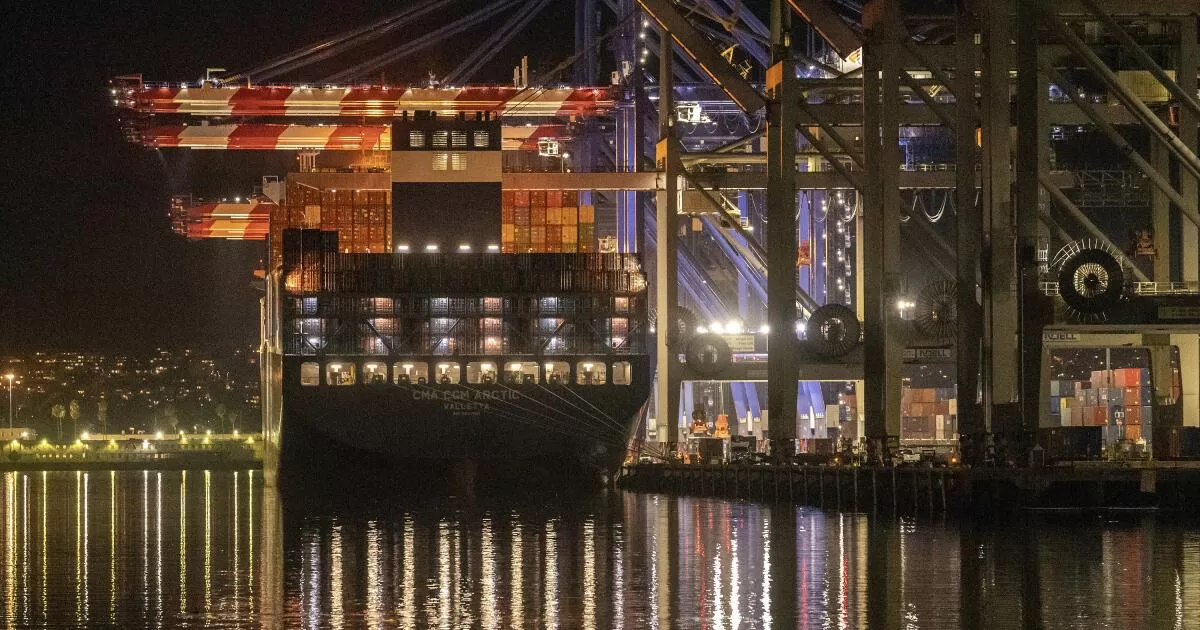Voters rank the economy and inflation as the most important issues facing the country, and in spite of good news on both fronts, discontent over pocketbook issues remains steady. There’s one stretch of Southern California where, one could say, that all began: Los Angeles’ harbor and coast.
As the center for U.S. Pacific trade and an archetype for exuberant housing markets everywhere, the region’s waterfront clarifies why so many Americans feel frustrated and under pressure — and just how challenging it may be to fix this, no matter who becomes the next president.
Stretching back to the mid-19th century, when the United States annexed Southern California from the Mexican Republic, Americans looked to Pacific trade and westward settlement to stabilize their nation. That’s why our local ports were developed.
In the 1850s, a federal agency, then called the U.S. Coast Survey, identified San Pedro Bay as a focal point for shipping efforts. Since the 1910s, this has been home to the Port of Los Angeles and the Port of Long Beach, collectively the busiest shipping hub in the Western Hemisphere, making the region prominent in global supply chains and transpacific trade.
Officials believed Pacific trade and settlement to be a safety valve for turmoil back East, that over slavery most of all. The results proved them wrong. Commerce and settlers intensified political conflict, both in Washington and in California, by increasing the stakes. Land speculators — in most places pushing out Indigenous people and Mexicans — looked to grab former rancho claims near California’s prospective harbors, in Southern California’s enviable climate. It was a rush for beachfront property like the region had never seen. Their actions set Los Angeles’ property lines and the basis for today’s real estate markets from Malibu to Newport Bay.
This history was invisible to me as I grew up around L.A., but its effects were and are all around, continuing to reshape Southern California during my lifetime. By the early 2000s, container ships, larger than before, accumulated in the outer waters as the ports were sometimes overwhelmed. Semitrucks crowded the 110 and 710 freeways. At the same time, the coastal real estate market boomed yet again. My parents — new arrivals to the region — found it full of opportunity. They purchased their first and only home, in a subdivision on former rancho lands, and they paid it off as valuations exploded around them and their nest egg grew. The region’s economy was a dynamo, a safe harbor in more ways than one.
Shipping and competitive real estate — two legacies of 1850s Southern California — remain with us. Moreover, they are part of an ongoing story of Los Angeles and its place in American life. Today’s voters’ sense of their economic well-being is based on the prices of household necessities, mostly imported goods, and about one-third enter the U.S. through the ports of Los Angeles and Long Beach. Historically, the ships and containers that crowd San Pedro Bay have expanded affordability, but the COVID-19 pandemic and international crises disrupted their flow. Suddenly transpacific trade was blamed for soaring costs, not credited with making household items affordable. Even after the disruption abated, high prices and memories of scarcity have lingered. Nationally, politicians and the public have come to doubt the virtues of globalization. The clash between high hopes for Los Angeles’ harbors and the realities of global trade contribute once more to Americans’ sense of an uncertain world, and once again the high stakes linked to Southern California’s economy feed into tensions nationwide.
Sure investments, meanwhile, no longer offset troubled times. Americans’ primary investment — triumphant in the post-World War II era — is the single-family home. However, the nation’s high-priced real estate has unsettled this convention. Rather than absorbing newcomers and providing a path to financial security, it has multiplied voters’ sense of distress by locking many out of homeownership. The exhilarating prices and low interest rates of recent decades — profit and security to prior home purchasers — now put inflationary pressure on renters and prospective buyers, and on middle-income, low-income or young voters especially. This is most true around coastal Los Angeles, west and south of the 405 Freeway. It is true as well in markets farther afield, such as Phoenix and Las Vegas, long shaped by Southern California migrants and money.
The Southland’s residents and visitors were drawn to the promise of Pacific waters, just as generations before have been. And while many in all eras have benefited from the region’s industries and real estate appreciation, many others have always been left behind. Remembering such connections with history can clarify uncertain times. Recent polarization in U.S. politics has been compared to the Civil War era, but there is perhaps a more apt parallel between today and the 1860s: the economic ideas of trade and land investment, intended to calm political passions and to distribute prosperity, fell short in both moments.
The consequences will play out in the months ahead as pocketbook issues quite likely decide the presidential election. But regardless of the election’s outcome, we should understand that Southern California is never a place apart from U.S. politics and its dilemmas. Instead, these have deep roots in the region. And today, the region continues to invest in imports and real estate as vehicles for prosperity — even as the adverse costs accumulate in national politics.
That makes Southern California the opportune place to resolve these dilemmas of history and to lead the U.S. forward, whether by policy experimentation or new principles for how wealth might be built, sustained and shared. Shaping the nation’s better future will involve tough choices. It certainly will take visionaries and daring. Yet that, too, is a legacy of Southern California’s past, one ready to be reclaimed.
James Tejani, an associate professor of history at Cal Poly San Luis Obispo, is the author of “A Machine to Move Ocean and Earth: The Making of the Port of Los Angeles and America.”
